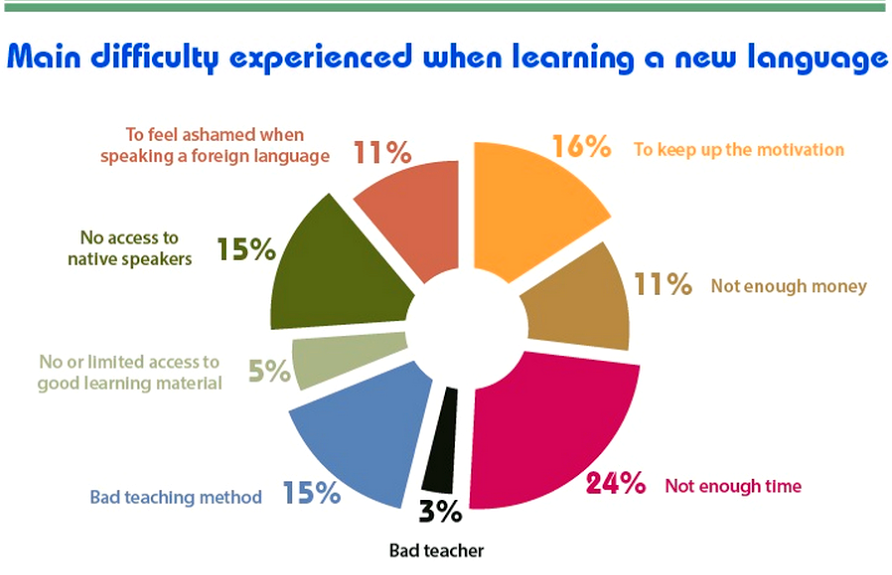Not enough time? Really? Language Learning and Setting Priorities
 (Updated 3-15-2021)
(Updated 3-15-2021)
Language learning and setting priorities go together.
Last month I a saw on the Google+ page of Finverbus an unattributed graph titled Main difficulty experienced when learning a new language. I don't know whose research produced the graph, nor the sample size or the demographics of those questioned, but I did not find the results surprising.
Of the 8 reasons listed, I thought I could certainly identify with the first two of them: #1: “Not Enough Time” and #2 “To keep up Motivation.”
I've just started to learn Dutch. We are planning a trip to the Netherlands later next year and I will keep a log of how I am doing regarding these two challenges.
Motivation for Language Learning
“To keep up Motivation” is listed as excuse #2 with 16% in the above referenced chart. Ads on TV or radio of happy people communicating in foreign countries or promoting how easy it is to learn a new language may even induce you to give language learning a try.
But it's well known in the language teaching community that a real need to communicate is the strongest and probably the most effective motivator.
How does my desire to learn Dutch rank on such a need scale? Probably not very high. Do I have to know Dutch for visiting the Netherlands? Not really. The relatives and friends we are visiting all speak English, German, or French, all languages I speak fluently. So there is no real “need” for me to communicate in Dutch.
So why am I learning Dutch? Really for three main reasons:
(1) as a test of how much I can learn with Duolingo, the program I am currently using, which I'll follow up with another online program later on. (Gamesforlanguage.com does not yet have a Dutch program.)
(2) whether I can use my wife's fluency in Dutch to augment my Dutch skills by the time we travel, and
(3) to record how my motivation holds up and what conclusions I can draw.
My goal is to establish a learning routine of initially 15 minutes a day – to get into the habit – then increase it to an average of one hour a day.
Not Enough Time
“Not enough time” is listed as excuse #1 by 24% of respondents. As an answer to a survey question this appears quite plausible: Learning a foreign language as an adult takes time – in fact more time than most learners (and most marketers) want to admit.
It is always good to remember how long it takes a child to learn his or her first language. It takes them a few years to learn to speak with some sophistication and several more years to fully master reading and writing.
And spending even an hour a day, 7 hours per week, 30 hours per month, or 365 hours during a year may be more time an adult is able or willing to commit.
But who hasn't heard the saying: “If you want to get something done, find a busy person.” Are busy persons just better at organizing and scheduling their time? Is “not enough time” maybe a convenient excuse, when the real reason, and not listed on the chart, could be: “Not able to manage my time effectively” or “Not able to set priorities”?
And that's also why I don't quite believe the results of the survey regarding the "not enough time" excuse.
It is a very convenient excuse, which may serve as an umbrella for all kinds of other reasons.
Setting Priorities for Language Learning
I'm as guilty as anyone of having used the excuse of “not enough time”for language learning, often and in various circumstances. However, when I am honest with myself, this excuse typically hides other reasons.
They may include preferring other activities that are, at the moment, more urgent or important, or maybe more fun or entertaining. In fact, throughout the day, we usually reset our priorities of what is urgent and important to accomplish.
To the extent that you have a job, a family, friends, and commitments, a good part of your day is already planned for. But most of us also have some “discretionary” time, or idle time, maybe during commuting, waiting, early in the morning, or later in the evening.
And it is here, in setting daily priorities, where motivation plays a major role: If your motivation is strong, you'll plan your day and re-arrange your priorities to make time to learn. (Our post 8 Zen Habits for Language Learning looks at how we can do this.)
But motivation can also fade over time. Learning Dutch seemed such a great idea, just a few weeks ago. But I'll watch out for MY excuses when I don't put in the daily 15 minutes (or the 1 hour later on). So far, I am still on a 20-day streak with Duolingo.
Update
I followed my schedule pretty much as planned - until we got to our Dutch family reunion in the fall. Then, with the urgency gone, I now typically re-start my Dutch practice again a few months before our annual trip to the Netherlands. (Did you you read the previous post: How P.M. Tools can help your language learning ?)
And due to Covid-19 we missed our dutch family reunion in 2020 - but I have continued my Duolingo Dutch course daily, and can read Dutch now quite well!
From time to time, Ulrike who speaks Dutch quite fluently, will test me a bit during our walks. My priorities for learning and practicing Dutch change with the seasons...
